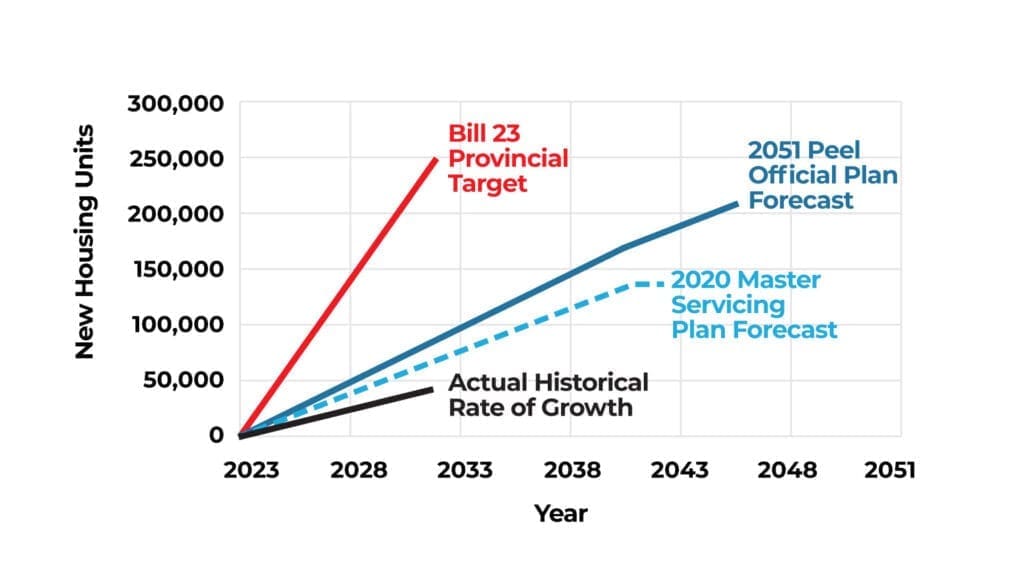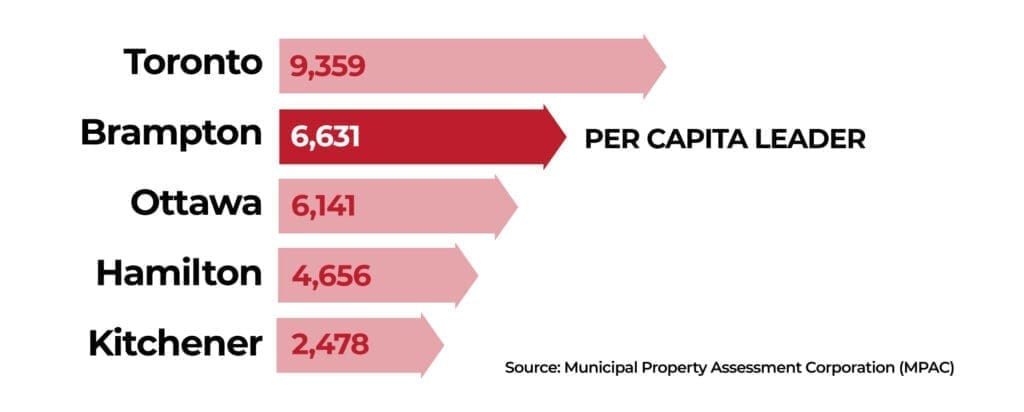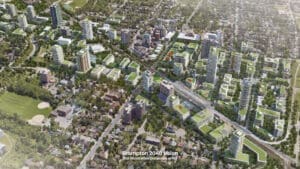Brampton is the fastest growing big city in Canada, with an annual population growth rate of 4%. Our population will rise from about 700,000 people to 1 million by 2051. This increase will be driven by immigration, investments in public transit, and our proximity to Toronto. Where will we all live?
Increasing the supply of housing all across Canada is universally accepted as an important solution to our housing crisis. Our federal and provincial governments have shown a financial commitment to help municipalities quickly increase our housing supply, particularly those that meet criteria related to affordability and intensification along transit.
Residential development applications in Brampton now represent 50% of all applications submitted in the Region of Peel. Brampton is leading Ontario on a per capita basis in building permit approvals. We have agreed to unlock more housing by streamlining development approvals, removing barriers, and accelerating planning in support of a bold Municipal Housing Pledge of 113,000 new homes built by 2031. This pledge does not include ARU (additional residential unit) conversions which are also helping to address housing. More people and housing also requires the City to pay for parks, recreation, community centres, libraries, transit, fire, police, paramedics, roads and other soft infrastructure that is critical to quality of life.
Provincial Departure from “A Place to Grow”
Peel Residential Unit Growth Forecast
Source: Progress on Infrastructure Planning to Support Bill 23 Housing Targets
Brampton is Ontario’s Per Capita Leader in Housing Construction
Per capita (100,000) Permits: Brampton 947
Who will fund the hard and soft infrastructure to support this rapid growth of housing? This huge burden cannot be placed on existing property tax payers alone. All orders of government need to support and provide additional tools to pay for growth (more on this in Part 4 of this series).
The Brampton Plan
The official Brampton Plan was revised to include updated growth targets for housing. The plan sets out an approach for guiding growth and development while reflecting Brampton’s evolution from a village to a bedroom community and now to an urbanizing city rich with built, natural, social and cultural resources.
I grew up in Brampton when low-density, auto-oriented, sprawling developments in greenfield spaces was the norm. Our greenfields are now nearly depleted and we are in the midst of a climate emergency. This reality provides us with the opportunity for urban revitalization and to design neighbourhoods where residents are able to undertake most of their daily needs within a 15-minute walk or short bicycle ride.
The Brampton Plan deliberately seeks to direct growth in a manner that is more compact and at higher densities so that municipal revenues and operating costs are in better balance. Higher density neighbourhoods are less expensive for the city to service (e.g. police, fire, ambulance, schools, water, sewer, streets, hydro corridors, parks, community centres, libraries).
Many residents who live in single-detached homes often infer that more compact and higher density neighbourhoods means tall towers everywhere. On the contrary, it means directing growth to the areas that can best support it and maximize use of infrastructure particularly near transit corridors. It also means pursuing a mix of housing options. Smarter land use approaches contained in the Brampton Plan reduce financial costs and help the city address climate change by reducing energy consumption, decreasing emissions, and promoting healthier lifestyles.
The Brampton Plan reduces red-tape and approves applications faster. In some cases it is the other orders of government standing in the way. An example is Riverwalk, a critical flood mitigation project that can be described as a more naturalized version of the Ottawa Canal which would:
- Unlock residential development potential currently limited in our downtown core
- Connect a regional transit network including GO Transit, Brampton, Mississauga, and York Transit systems
- Connect to active transportation arteries
- Provide park and recreation spaces and entertainment venues
- Increase economic activity by bringing customers directly into the downtown core to support small businesses
Riverwalk Flood Mitigation Awaiting Provincial Funding
Brampton has already budgeted for this major infrastructure project and the federal government has committed to its share. Unfortunately, the provincial government has yet to commit to the project effectively hindering their own growth targets and strategy.
Who Pays for Services
As we move away from the sprawling sub-urban neighbourhoods I grew up in to build housing that is relevant and essential in today’s housing crisis, there is a crucial caveat that is being overlooked but not unnoticed.
The conversion of single-detached and semi-detached houses into multi-unit dwellings is an organic market response that has helped fill a need. The federal and provincial governments realize the benefits of these conversions and have legislated municipalities to implement housing options such as ‘additional rental units’ (ARUs). The challenge is that ARUs do not necessarily count towards our housing target of 113,000. This means that funding is not available to support this type of housing growth. Furthermore, if kept unregulated the ARU rental market will continue to have consequences as unaccountable landlords undermine property standards and basic health and safety of tenants. Brampton has taken proactive measures to understand the impact of ARUs by implementing a “Licensing Landlord” program. In addition to prioritizing health and safety, and holding landlords to account for their properties, the program collects data to quantify the number of ARUs in our local neighbourhoods and their impact

New Brampton licensing program to hold landlords accountable
A two-year pilot program for a rental landlord registration/licensing program in Brampton was passed at Committee of Council today (March 29, 2023). The motion was moved today by Councillor Rowena Santos and seconded by Councillor Dennis Keenan. The motion is expected to pass at the next city council meeting.
Without corresponding financial support or tools from other orders of government, municipalities alone cannot afford to invest in the necessary hard and soft infrastructure that would support such growth. ARUs put added pressure on property taxes as they increase the average number of residents in a single-detached home. A home that houses more people than originally designed, means there are more people using municipal services without any increase in property tax revenue to service them. This is a very significant cost that existing property tax payers will be unfairly asked to pay for.
Brampton needs other orders of government to collaborate in funding and policy initiatives that not only create new housing options, but also support the quality of life for all residents. With limited revenue streams, municipalities cannot do this alone.







